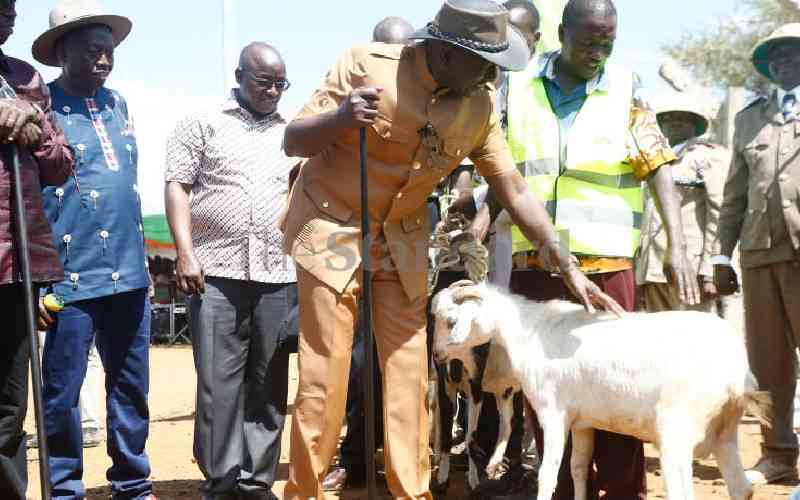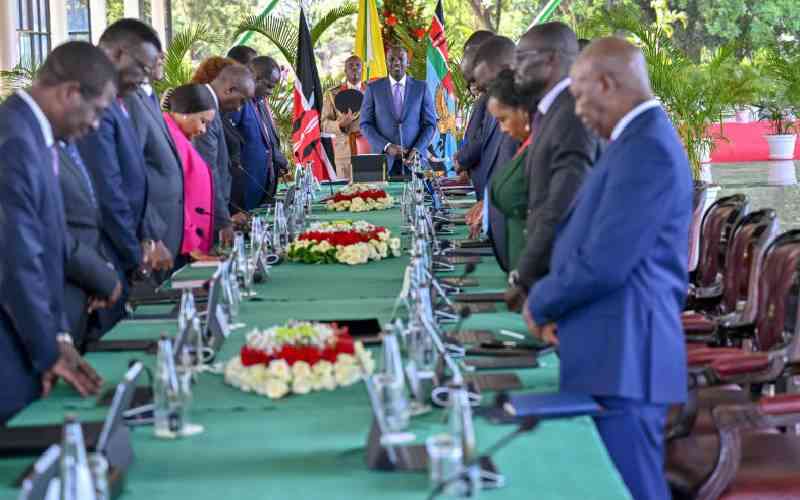 |
|
Nairobi OCPD JM Oswald (left) with other police officers examine recovered cash. |
By Joseph Karimi
In the early 1970s, gangsters ran amok in Nairobi. There were so many robberies in the city that everyone was concerned. Bank heists became so common that the police force, which had only recently been Africanised, was brought into disrepute.
Armed robbers turned the city into a gangland and banks and other financial institutions were on the receiving end. People were scared. President Jomo Kenyatta was annoyed.
He called the then director of the Criminal Investigations Department (CID), Ignatius Nderi, and expressed his disapproval of the situation.
He said: “Look, what is happening? Are we being controlled by thugs? Are we under the control of thugs and criminals, robbing banks and harassing law-abiding citizens at will? There is no order here. What is wrong?”
In an interview in 1992, Nderi recalled that the Head of State was furious and wanted something done to stop the gangsters. But there was a problem. Policemen were not allowed to carry guns.
At independence in 1963, the armed crime rate in Kenya was very low in contrast to a quick rise within the first decade. The sudden rise was attributed to, among other things, the Ugandan political crises that brought Idi Amin into the limelight on January 3, 1971, after he toppled President Milton Obote in a military coup. Obote was attending a Commonwealth conference in Australia at the time.
Military rule under Amin, lasting until 1979, pushed an economically stable Uganda into political and economic instability culminating in the massacre of thousands of Ugandans in a systematic organised elimination, particulary of government opponents. Anarchy substituted the democratic order of the highly respected ethnic kingdoms, the most prominent being that of Kabaka Yekka, King of Buganda.
Kenya, the immediate neighbouring country, felt the impact. Goods en route from the Mombasa sea port to landlocked Uganda had to pass through Kenya. Thus, Kenya shared the ills of instability and disorder in Uganda. One of the major evils imported from a collapsed system of law and order in Uganda was the proliferation of arms of all kinds, and ammunition.
Guns On The Loose
Guns of all calibres on the loose in Uganda were imported and became accessible to anyone who needed them. It was a field day for robbers in Kenya — the big and small timers could now make a killing. Crime became a way of life.
The then Assistant Commissioner of Police, JM Oswald, who commanded Nairobi Area Police Division (OCPD) maintained the status quo of the regular police force under him, ensuring that they patrolled the streets of the capital city of Nairobi like their counterpart “bobbies” on the streets of London. This was the norm for the force under white police bosses.
While robbers were armed to the teeth, Oswald’s policemen on the beat carried 18-inch long batons knotted with a leather handle. Against this backdrop, Kenyatta wanted to know why gangsters were harassing people in Nairobi without a worry.
Nderi had been appointed CID Director in 1973, succeeding the first African to hold that position, Peter Ochieng Okolla. At the time, Nderi was in charge of Nairobi Area.
“Those were the days when nobody shot robbers. Oswald wanted the police in Nairobi Area to be like the British ‘bobbies’,” he said.
Stay informed. Subscribe to our newsletter
Nderi emphasised that the Nairobi gangsters were armed with dangerous weapons. “A time came when police in uniform were too scared of coming in contact with those armed robbers. Only the CID men were left to chase these armed criminals. Uniformed policemen did not carry guns and were reduced to cowards; they were afraid of these criminals.”
Oswald was the last European OCPD in Nairobi Area. He was succeeded by JJ Mageria. During his time, Oswald, according to Nderi, “was against anybody carrying a gun…there was no other way. Meanwhile, robbers were getting guns from Uganda. Many guns were imported by ‘kondo’, their Ugandan criminal counterparts, who also partnered with local criminals for joint robbery operations.”
Protect Criminals
It was at the height of all this chaos that Kenyatta called Nderi.
The CID boss was on the carpet. He had to justify his worth. He recalled: “I said to the late President: ‘Look, it’s not that we cannot control these people but first of all we do not have enough motor vehicles. We do not have guns because Oswald says no guns will be issued to CID men; he has refused guns to be issued to his own regular policemen.”
Nderi continued: “I requested the President to give me a free hand and promised to deal with the situation. He then summoned the Attorney General Charles Njonjo and his Deputy James Karugu. The President wanted to know whether we were there to protect the criminals or law-abiding citizens and financial institutions.”
“When the two arrived,” said Nderi, “I stated to them that unless we armed our men and provided enough vehicles to move, and were given the mandate to shoot any criminals who refused to surrender, there was no way we could control the rising crime.”
New Powers
He recalled that Mr Njonjo was asked to give his opinion and it was decided by the late President that policemen who shot dead armed robbers who refused to surrender would not be held responsible in the eyes of the law. In other words, they would not be prosecuted.”
President Kenyatta then summoned the Commissioner of Police, Bernard Hinga, and Oswald, and the government decision was conveyed to them. Guns and transport would be made available to both the regular police and the CID.
Nderi recalled: “I asked a furious President Kenyatta to give me one month to deal with the criminals, but he said that period was too long and halved it, giving me two weeks to act.
“When I left State House, I devised a way to beat the robbers at their own game, now that we had the equipment to fight them. I carefully studied the escape routes they used in their getaway cars to escape with the loot after hitting the banks and other financial institutions.”
The solution was to pinpoint strategic spots along these escape routes where police could create bottle-necks and jam the vehicular movement.
He studied the routes and drilled CID crews on this exercise so that when a robbery was reported, they could move quickly to all the spots by mobilising the ‘999’ Patrol Cars in the city centre to block the exits.
Nderi said after a robbery was reported, his men chased the robbers, forcing them to drive into the strategic bottlenecks that included clogged streets.
Thus the robbers, in their haste to escape, were left with no alternative but to abandon their getaway cars and run on foot with the loot.
Armed policemen littered the streets. Nderi said with time bank robberies went down by five per cent. Within two weeks, at least 10 armed robbers had been shot dead.
Ad Hoc Measure
“Some robbers got so scared that they telephoned us to reveal where they were going to dump their guns. We recovered the weapons at the specific place. One prominent robber went as far as surrendering two guns to President Kenyatta and pleading for a reprieve, saying he suspected the CID were on his heels and he feared being shot dead.”
The President pardoned the robber against his word that he would reform.
However, the war on crime by the CID was just an ad hoc measure. President Kenyatta directed the Office of the Attorney General to draft Criminal (Amendment) Bill 1971, seeking a mandatory death sentence for robbery with violence where gangsters caused grievous harm to their victims while committing a robbery.
 The Standard Group Plc is a
multi-media organization with investments in media platforms spanning newspaper
print operations, television, radio broadcasting, digital and online services. The
Standard Group is recognized as a leading multi-media house in Kenya with a key
influence in matters of national and international interest.
The Standard Group Plc is a
multi-media organization with investments in media platforms spanning newspaper
print operations, television, radio broadcasting, digital and online services. The
Standard Group is recognized as a leading multi-media house in Kenya with a key
influence in matters of national and international interest.
 The Standard Group Plc is a
multi-media organization with investments in media platforms spanning newspaper
print operations, television, radio broadcasting, digital and online services. The
Standard Group is recognized as a leading multi-media house in Kenya with a key
influence in matters of national and international interest.
The Standard Group Plc is a
multi-media organization with investments in media platforms spanning newspaper
print operations, television, radio broadcasting, digital and online services. The
Standard Group is recognized as a leading multi-media house in Kenya with a key
influence in matters of national and international interest.








